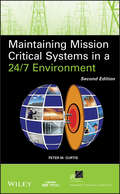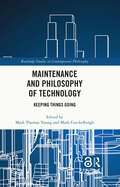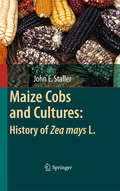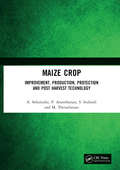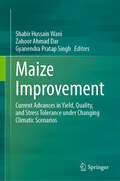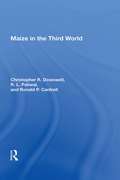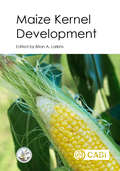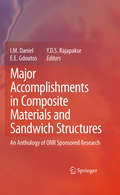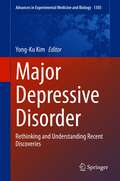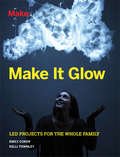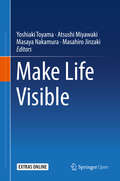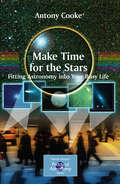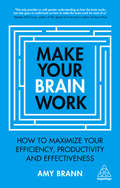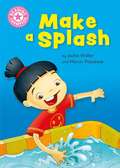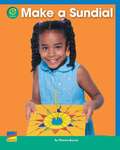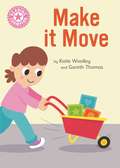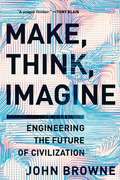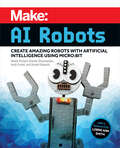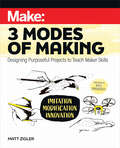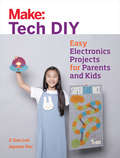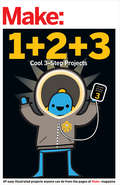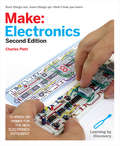- Table View
- List View
Maintaining Mission Critical Systems in a 24/7 Environment, 2nd Edition
by Peter M. CurtisThis book is meant to offer Architects, Property Mangers, Facility Managers, Building Engineers, Information Technology Professionals, Data Center Personnel, Electrical & Mechanical Technicians and students in undergraduate, graduate, or continuing education programs relevant insight into the Mission Critical Environment with an emphasis on business resiliency, data center efficiency, and green power technology. Industry improvements, standards, and techniques have been incorporated into the text and address the latest issues prevalent in the Mission Critical Industry. An emphasis on green technologies and certifications is presented throughout the book. In addition, a description of the United States energy infrastructure's dependency on oil, in relation to energy security in the mission critical industry, is discussed. In conjunction with this, either a new chapter will be created on updated policies and regulations specifically related to the mission critical industry or updates to policies and regulations will be woven into most chapters. The topics addressed throughout this book include safety, fire protection, energy security and data center cooling, along with other common challenges and issues facing industry engineers today.
Maintenance and Philosophy of Technology: Keeping Things Going (Routledge Studies in Contemporary Philosophy)
by Mark Coeckelbergh Mark Thomas YoungWhat can we learn about the nature of technology by studying practices of maintenance and repair? This volume addresses this question by bringing together scholarship from philosophers of technology working at the forefront of this emerging and exciting topic.The chapters in this volume explore how attending to maintenance and repair can challenge and complement existing ways of thinking about technology focused on use and design and introduce new philosophical perspectives on the relationship between technology, time and human practice. They examine the significance of maintenance and repair practices at different scales in relation to a diverse range of philosophical traditions and a wide variety of technologies, from urban infrastructure such as bridges and buildings to data technologies such as servers and software systems. Together, the contributions highlight common themes in the philosophical study of maintenance, including the role of skill, the significance of social values and the potential of these practices to transform the technologies to which they are applied. By reflecting on the different ways in which we keep technologies going, from the devices we use in our homes to the large technical systems which surround us, this volume reveals the philosophical significance of practices of maintenance, not only as a source of new insights but also as a resource for enriching our understanding of a variety of existing topics in philosophy.Maintenance and Philosophy of Technology will appeal to scholars and advanced students working in philosophy of technology, philosophy of engineering and science & technology studies.Chapter 9 of this book is freely available as a downloadable Open Access PDF at www.taylorfrancis.com under a Creative Commons Attribution-Non Commercial-No Derivatives (CC-BY-NC-ND) 4.0 license.
Maize Cobs and Cultures: History of Zea mays L.
by John StallerOur perceptions and conceptions regarding the roles and importance of maize to ancient economies is largely a product of scientific research on the plant itself, developed for the most part out of botanical research, and its recent role as one of the most important economic staples in the world. Anthropological research in the early part of the last century based largely upon the historical particularistic approach of the Boasian tradition provided the first evidence that challenged the assumptions about the economic importance of maize to sociocultural developments for scholars of prehistory. Subsequent ethnobotanic and archaeological studies showed that the role of maize among Native American cultures was much more complex than just as a food staple. In Maize Cobs and Cultures, John Staller provides a survey of the ethnohistory and the scientific, botanical and biological research of maize, complemented by reviews on the ethnobotanic, interdisciplinary and multidisciplinary methodologies.
Maize Crop: Improvement, Production, Protection and Post Harvest Technology
by A. Solaimalai P. Anantharaju S. Irulandi M. TheradimaniMaize is one of the versatile emerging crops with wider adaptability under varied agro-climatic conditions. Globally, maize is known as queen of cereals because it has the highest genetic yield potential among the cereals. It is cultivated on nearly 150 m/ha in about 160 countries having wider diversity of soil, climate, biodiversity and management practices that contributes 36 % (782 m/t) inthe global grain production. The United States of America (USA) is the largest producer of maize contributes nearly 35 % of the total production in the world. It is the driver of the US economy. This book talks about the improvement, production, protection and post harvest technology of the maize crop. Note: T& F does not sell or distribute the Hardback in India, Pakistan, Nepal, Bhutan, Bangladesh and Sri Lanka.
Maize Improvement: Current Advances in Yield, Quality, and Stress Tolerance under Changing Climatic Scenarios
by Shabir Hussain Wani Zahoor Ahmad Dar Gyanendra Pratap SinghMaize is one of the most generally grown cereal crops at global level, followed by wheat and rice. Maize is the major crop in China both in terms of yield and acreage. In 2012, worldwide maize production was about 840 million tons. Maize has long been a staple food of most of the global population (particularly in South America and Africa) and a key nutrient resource for animal feed and for food industrial materials. Maize belts vary from the latitude 58° north to the latitude 40° south, and maize ripens every month of the year. Abiotic and biotic stresses are common in maize belts worldwide. Abiotic stresses (chiefly drought, salinity, and extreme temperatures), together with biotic stresses (primarily fungi, viruses, and pests), negatively affect maize growth, development, production and productivity. In the recent past, intense droughts, waterlogging, and extreme temperatures have relentlessly affected maize growth and yield. In China, 60% of the maize planting area is prone to drought, and the resultant yield loss is 20%–30% per year; in India, 25%–30% of the maize yield is lost as a result of waterlogging each year. The biotic stresses on maize are chiefly pathogens (fungal, bacterial, and viral), and the consequential syndromes, like ear/stalk rot, rough dwarf disease, and northern leaf blight, are widespread and result in grave damage. Roughly 10% of the global maize yield is lost each year as a result of biotic stresses. For example, the European corn borer [ECB, Ostrinianubilalis (Hübner)] causes yield losses of up to 2000 million dollars annually in the USA alone in the northern regions of China, the maize yield loss reaches 50% during years when maize badly affected by northern leaf blight. In addition, abiotic and biotic stresses time and again are present at the same time and rigorously influence maize production. To fulfill requirements of each maize-growing situation and to tackle the above mentions stresses in an effective way sensibly designed multidisciplinary strategy for developing suitable varieties for each of these stresses has been attempted during the last decade. Genomics is a field of supreme significance for elucidating the genetic architecture of complex quantitative traits and characterizing germplasm collections to achieve precise and specific manipulation of desirable alleles/genes. Advances in genotyping technologies and high throughput phenomics approaches have resulted in accelerated crop improvement like genomic selection, speed breeding, particularly in maize. Molecular breeding tools like collaborating all omics, has led to the development of maize genotypes having higher yields, improved quality and resilience to biotic and abiotic stresses. Through this book, we bring into one volume the various important aspects of maize improvement and the recent technological advances in development of maize genotypes with high yield, high quality and resilience to biotic and abiotic stresses
Maize In The Third World
by Christopher DowswellMaize is the world's most widely grown cereal and a dietary staple throughout the Third World, but its full potential has only begun to be tapped. This book thoroughly examines the biological and economic issues relevant to improving the productivity of maize in developing countries. The authors explore a wide range of practical problems, from maxi
Maize Kernel Development
by Brian A. LarkinsThis is an authoritative book that acts as a guide to understanding maize kernel development. Written by a team of experts, it covers topics spanning pre- and post-fertilization events, embryo and endosperm development, grain filling and maturation, and factors influencing crop yield. It explores the significance of maize and other cereal grains, existing hypotheses and research, and important gaps in our knowledge and how we might fill them. This is a valuable resource for researchers of maize and other cereals, and anyone working on basic or applied science in the fields of seed development, plant genetics, and crop physiology.
Major Accomplishments in Composite Materials and Sandwich Structures
by Yapa D.S. Rajapakse E. E. Gdoutos I. M. DanielThis book represents a collection of major research contributions over the last decade in the area of composite materials and sandwich structures supported by the U.S. Office of Naval Research. It contains over thirty chapters written by recognized experts in their fields and serves as a reference and guide for future research. Topics covered include: mechanical and failure characterization of composites under static and dynamic loading; failure modes and failure criteria; environmental effects; dynamic effects; post impact behavior; multiscale modeling; nanocomposites; characterization of core materials for sandwich structures under static and fatigue loading; mechanical behavior and failure of sandwich structures; fatigue behavior and durability of composite materials and sandwich structures; core joints in sandwich structures; characterization and failure of marine materials and structures under impulse loading; failure of interfaces under dynamic loading; delamination failure of composite materials and sandwich structures; response of composites and sandwich structures to blast loading and underwater explosions.
Major Depressive Disorder: Rethinking and Understanding Recent Discoveries (Advances in Experimental Medicine and Biology #1305)
by Yong-Ku KimThis book reviews all aspects of major depressive disorder (MDD), casting light on its neurobiological underpinnings and describing the most recent advances in management. The book is divided into four sections, the first of which discusses MDD from a network science perspective, highlighting the alterations in functional and structural connectivity and presenting insights achieved through resting state functional MRI and the development of neuroimaging-based biomarkers. The second section examines important diagnostic and neurobiological issues, while the third considers the currently available specific treatments for MDD, including biofeedback, neurofeedback, cognitive behavioral therapy, acceptance and commitment therapy, neuromodulation therapy, psychodynamic therapy, and complementary and alternative medicine. A concluding section is devoted to promising emerging treatments, from novel psychopharmacological therapies through to virtual reality treatment, immunotherapy, biomarker-guided tailored therapy, and more. Written by leading experts from across the world, the book will be an excellent source of information for both researchers and practitioners.
Major Events in Early Vertebrate Evolution
by Per Erik AhlbergA multi-author volume Major Events in Early Vertebrate Evolution examines the origin and early evolution of the backboned animals (vertebrates)-the group which comprises all fishes, amphibians, reptiles, birds and mammals, including ourselves. This volume draws together evidence from fossils, genes, and developmental biology (the study of how embry
Make It Glow: LED Projects for the Whole Family
by Emily Coker Kelli TownleyEveryone loves to play with light and this collection of kid-ready LED projects will have young Makers exploring electricity and electronics while opening up a world of endless fun! Makers, tinkerers, hobbyists, and parents will be drawn to the decorative and exciting possibilities of the projects in Make It Glow. Filled with full-color photographs and step-by-step instructions that anyone can follow, this beautiful book features 21 exciting projects that can be completed by even the youngest Maker. You'll start with ultra simple projects and then tackle increasingly complicated ones. Building upon lessons learned in earlier projects ensures that kids learn and succeed. Everyone will be thrilled by the fun, decorative designs that result as you develop new ways to unleash your creativity!With Make It Glow, you'll learn to make: Blue-light greeting cardsEyes in the dark FlickerbugsLight-up fairy wingsAn illuminated tote bagA bouquet of electric rosesand more!Featuring beautifully photographed inspirational projects for kids and adults, Make It Glow helps you learn the basics of electronics and soft circuits to create costumes, home decorations, clothing, jewelry, and more. What will you illuminate?
Make Life Visible
by Masaya Nakamura Yoshiaki Toyama Atsushi Miyawaki Masahiro JinzakiThis open access book describes marked advances in imaging technology that have enabled the visualization of phenomena in ways formerly believed to be completelyimpossible. These technologies have made major contributions to the elucidation of the pathology of diseases as well as to their diagnosis and therapy. The volume presents various studies from molecular imaging to clinical imaging. It also focuses on innovative, creative, advanced research that gives full play to imaging technology inthe broad sense, while exploring cross-disciplinary areas in which individual research fields interact and pursuing the development of new techniques where they fuse together. The book is separated into three parts, the first of which addresses the topic of visualizing and controlling molecules for life. Th e second part is devoted to imaging of disease mechanisms, while the final part comprises studies on the application of imaging technologies to diagnosis and therapy. Th e book contains the proceedings of the 12th Uehara International Symposium 2017, “Make Life Visible” sponsored by the Uehara Memorial Foundation and held from June 12 to 14, 2017. It is written by leading scientists in the field and is an open access publication under a CC BY 4.0 license.
Make Time for the Stars
by Antony CookeMany amateur astronomers are short of time. A full-time career usually takes up most waking hours, and often there simply isn't time for leisurely observing. Fortunately, modern technologies such as computer-controlled telescopes, GPS, north-seeking and level detection, have made telescope set-up much quicker. Today's imaging systems enable astronomers to take excellent astrophotographs without the hours-long exposures. Make Time for the Stars explains what to try on a tight schedule, and how to use today's equipment to get the most astronomy out of the least time. This book showcases a wide array of quickly performed astronomical projects, including various novel or new approaches to observing. There are also practical tips for maximizing time at the telescope, extracting optimal performance, quick and efficient set-up, and easily carried out optical maintenance. Significantly, the book features detailed information on alternative imaging techniques with simple and less time-consuming efforts.
Make Your Brain Work: How to Maximize Your Efficiency, Productivity and Effectiveness (Kogan Page Ser.)
by Amy BrannDo you know how your brain functions? Do you sometimes feel like you're fighting your own brain and habits in order to be productive at work? What if there was a way to work with your brain to become more efficient, effective and productive... and transform the way you operate? Make Your Brain Work is here to help. Author Amy Brann is fascinated by the application of brain science to business, and you don't have to be an expert to understand - she explains the principles and latest insights in practical and easy-to-understand language, enabling you to understand the way you work, and form the helpful habits that will revolutionize your output. With clear, in-context examples; hands-on tips; and focused case studies on how companies are doing things well and the pitfalls to avoid, this entertaining book will help you reduce the stress and overwhelm of poor time management, and help get you to that next professional level. Including brand-new content on developing resilience and creativity, and managing your work-life balance, now it's even easier to Make Your Brain Work!
Make a Splash: Independent Reading Non-Fiction Pink 1a (Reading Champion #515)
by Jackie WalterThis book is part of Reading Champion, a series carefully linked to book bands to encourage independent reading skills, developed with UCL Institute of Education (IOE)Make a Splash is a non-fiction text exploring how different people can make a splash in water. The repeated sentence structure offers readers the opportunity for a very first independent reading experience with the support of the illustrations.Reading Champion offers independent reading books for children to practise and reinforce their developing reading skills.This early non-fiction text is accompanied by engaging artwork and a reading activity. Each book has been carefully graded so that it can be matched to a child's reading ability, encouraging reading for pleasure.
Make it Move: Independent Reading Pink 1B Non-fiction (Reading Champion #515)
by Katie WoolleyMake it Move is an informaiton book about pushing and pulling objects for children starting to learn to read. This book is part of Reading Champion, a series carefully linked to book bands to encourage independent reading skills, developed with Dr Sue Bodman and Glen Franklin of UCL Institute of Education (IOE)Reading Champion offers independent reading books for children to practise and reinforce their developing reading skills.Fantastic, original texts are accompanied by engaging artwork and a reading activity. Each book has been carefully graded so that it can be matched to a child's reading ability, encouraging reading for pleasure.
Make, Think, Imagine: Engineering The Future Of Civilization
by John BrowneAn impassioned defense of progress and innovation—and an argument for social responsibility from engineer, businessman, and former CEO of BP Lord John Browne. Today's unprecedented pace of change leaves many people wondering what new technologies are doing to our lives. Has social media robbed us of our privacy and fed us with false information? Are the decisions about our health, security and finances made by computer programs inexplicable and biased? Will these algorithms become so complex that we can no longer control them? Are robots going to take our jobs? Will better health care lead to an aging population which cannot be cared for? Can we provide housing for our ever-growing urban populations? And has our demand for energy driven the Earth's climate to the edge of catastrophe? John Browne argues that we need not and must not put the brakes on technological advance. Civilization is founded on engineering innovation; all progress stems from the human urge to make things and to shape the world around us, resulting in greater freedom, health and wealth for all. Drawing on history, his own experiences and conversations with many of today's great innovators, he uncovers the basis for all progress and its consequences, both good and bad. He argues compellingly that the same spark that triggers each innovation can be used to counter its negative consequences. Make, Think, Imagine provides an eloquent blueprint for how we can keep moving towards a brighter future.
Make: Create Amazing Robots with Artificial Intelligence Using micro:bit
by Reade Richard Brenda Shivanandan Andy Forest Denzel EdwardsArtificial intelligence is a tool to explore and create, and it starts here with the experts at Steamlabs, a nonprofit that teaches teens to not just be users of technology, but to create with technology so they can be help shape our future.Make: AI Robots introduces young people to AI through exciting craft projects that start with a mechanical cardboard creation, integrates fun electronic lights and motors, adds simple coding on a micro:bit, and then teaches how to train AI to create a spark of life.With 32 projects designed to guide beginners through increasing challenges, Make: AI Robots is the perfect way to feed curious minds with fun AI experiments that will delight and inspire.
Make: Designing Purposeful Projects to Teach Maker Skills
by Matt ZiglerThe Maker movement has been an excellent opportunity for people to become producers rather than just consumers, and schools are recognizing the value of offering students the tools, materials, and skills necessary to design sophisticated and meaningful projects. But teaching technical skills should not be the end goal: At its best, a Maker education teaches students to think and act in creative ways that can be applied to difficult challenges in all areas of life.Three Modes of Making provides a framework for Maker courses in upper grades that teach students creative-process skills through three key Maker modes: Imitation, Modification, and Innovation. Educators will learn the differences between the three Maker modes, their associated skill sets, and gain concrete methods to teach, document, and assess these skills. Through this approach, teachers will enable students to apply them to different creative needs.By focusing on how to teach skill development rather than merely how to build specific objects, Three Modes of Making enables students to improve and enhance their creative skills, and learn ways to apply them to a wide variety of challenges. This book is a road map to developing the creative problem solvers that the world needs for the future.
Make: Down-to-Earth Rocket Science
by Mike WesterfieldThis book teaches the reader to build rockets--powered by compressed air, water, and solid propellant--with the maximum possible fun, safety, and educational experience.Make: Rockets is for all the science geeks who look at the moon and try to figure out where Neil Armstrong walked, watch in awe as rockets lift off, and want to fly their own model rockets. Starting with the basics of rocket propulsion, readers will start out making rockets made from stuff lying around the house, and then move on up to air-, water-, and solid propellant-powered rockets. Most of the rockets in the book can be built from parts in the Estes Designer Special kit.
Make: Easy Electronics Projects for Parents and Kids
by Jaymes Dec Ji Sun LeeKid Crafts introduces younger children to the magic of electronics through the softer side of circuits! Young explorers will learn about electronics through sewing and craft projects aimed at maker parents and their children, elementary school teachers, and kids' activity leaders. Each project introduces new skills and new components in a progressive series of projects that take learners from the very basics to understanding how to use components such as sensors, transistors, and timers. The book is breezy, highly illustrated, and fun for everyone!
Make: From the Pages of Make:
by The Editors of Make:From the pages of Make: magazine comes this collection of dozens of projects you can make in your home or school workshop. You'll learn how to create toys and games from stuff you have lying around, create unusual and inspiring home improvements, and even find some new ways to have fun outdoors. You might even learn something along the way: electronics, flight, science, math, and engineering. In this book, you'll make:Batteries from everyday thingsBanana tattoosLED throwiesPiezo contact microphonePaper water bomberBox fan beef jerky
Make: Learning Through Discovery (Make Ser.)
by Charles Platt"This is teaching at its best!"--Hans Camenzind, inventor of the 555 timer (the world's most successful integrated circuit), and author of Much Ado About Almost Nothing: Man's Encounter with the Electron (Booklocker.com)"A fabulous book: well written, well paced, fun, and informative. I also love the sense of humor. It's very good at disarming the fear. And it's gorgeous. I'll be recommending this book highly."--Tom Igoe, author of Physical Computing and Making Things TalkA "magnificent and rewarding book. ... Every step of this structured instruction is expertly illustrated with photos and crisp diagrams. . . . This really is the best way to learn."--Kevin Kelly, in Cool ToolsThe first edition of Make: Electronics established a new benchmark for introductory texts. This second edition enhances that learning experience.Here you will find unique, photographically precise diagrams of breadboarded components, to help you build circuits with speed and precision. A new shopping guide and a simplified range of components, will minimize your investment in parts for the projects. A completely new section on the Arduino shows you how to write properly structured programs instead of just downloading other people's code. Projects have been reworked to provide additional features, and the book has been restructured to offer a step-by-step learning process that is as clear and visually pleasing on handheld devices as it is on paper. Full color is used throughout.As before, Make: Electronics begins with the basics. You'll see for yourself how components work--and what happens when they don't. You'll short out a battery and overheat an LED. You'll also open up a potentiometer and a relay to see what's inside. No other book gives you such an opportunity to learn from real-life experiences.Ultimately, you will build gadgets that have lasting value, and you'll have a complete understanding of how they work. From capacitors to transistors to microcontrollers--it's all here.Hans Camenzind, inventor of the 555 Timer (the world's most successful integrated circuit chip), said that "This is teaching at its best!" when he reviewed the first edition. Now the second edition offers even more!
